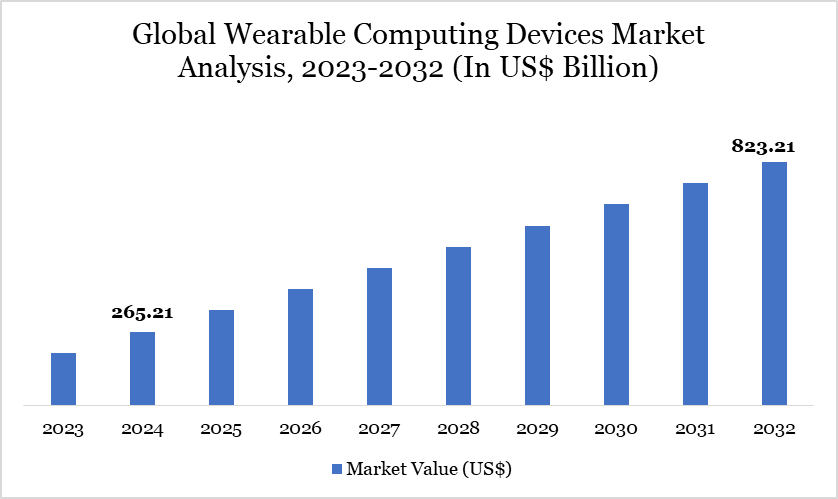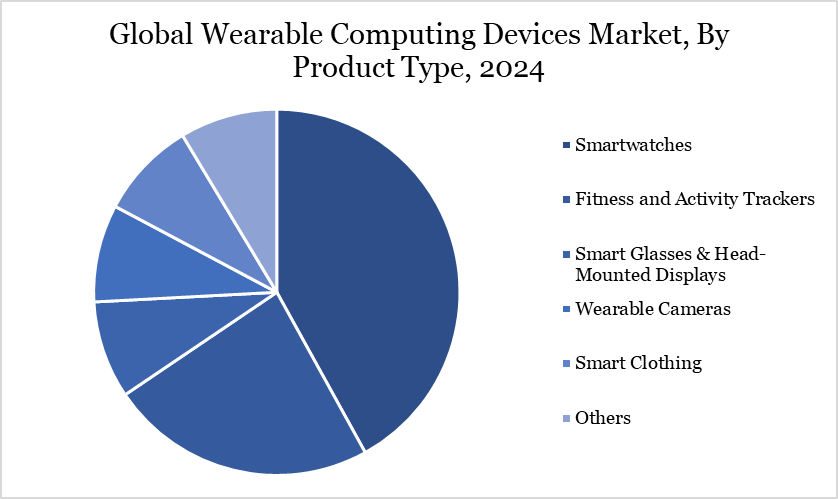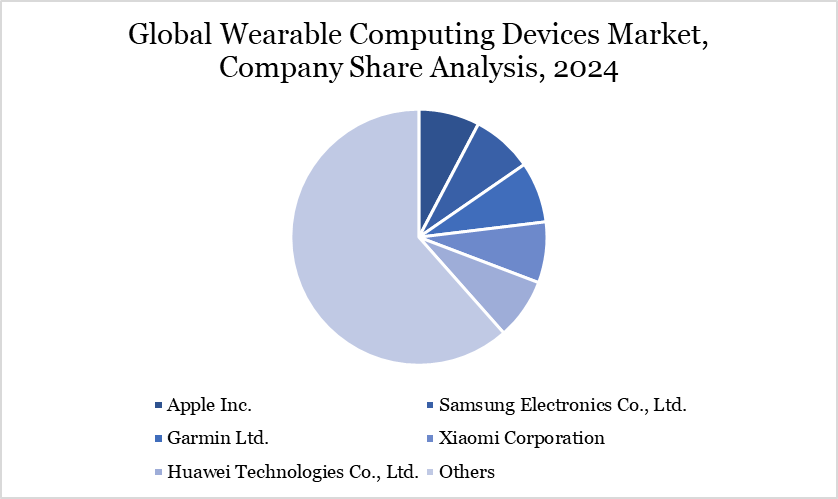Market Size
The Global Wearable Computing Devices Market reached US$265.21 billion in 2024 and is expected to reach US$823.21 billion by 2032, growing at a CAGR of 15.21% during the forecast period 2025-2032.
The wearable computing devices market is experiencing dynamic growth, fueled by the rising adoption of smartwatches, fitness bands, and health monitoring tools. These devices are increasingly integrated into daily life for tracking physical activity, heart rate, sleep patterns, and other vital health metrics. Government health agencies, such as the NIH and CDC, have acknowledged the growing role of wearable tech in preventive care and chronic disease management, particularly in remote patient monitoring scenarios.
In North America, demand is supported by a strong digital health infrastructure and growing health awareness among the population. Surveys from national health databases indicate that a significant portion of adults use wearable devices and are willing to share data with healthcare providers. This shows an expanding shift toward personalized healthcare, supported by connected, real-time monitoring through wearable technology.
Wearable Computing Devices Market Trend
A notable trend in the wearable computing devices market is the fusion of technology with fashion and lifestyle products. Companies are collaborating with fashion brands to create smart garments and accessories that combine style with functionality. This fusion is expanding the appeal of wearable tech beyond fitness enthusiasts to fashion-forward consumers. As a result, wearables are increasingly seen not just as health tools, but as lifestyle statements, enhancing both utility and personal expression.
For instance, in November 2020, Samsung Electronics Co., Ltd. partnered with fashion designer Thom Browne to introduce a limited edition of the Samsung Galaxy Z Fold 2 smartphone, blending high fashion with advanced technology. This convergence caters to consumer demand for wearable devices that seamlessly integrate into their daily lives, offering both aesthetic appeal and technological utility.

For more details on this report, Request for Sample
Market Scope
| Metrics | Details |
| By Product Type | Smartwatches, Fitness and Activity Trackers, Smart Glasses & Head-Mounted Displays, Wearable Cameras, Smart Clothing and Others |
| By Connectivity | Bluetooth, WiFi, GPS and Others |
| By Operating system | Android, Linux, Tizen and Others |
| By Application | Consumer Electronics, Healthcare & Medical, Sports & Fitness, Industrial & Enterprise, Defense & Military and Others |
| By Region | North America, South America, Europe, Asia-Pacific and Middle East and Africa |
| Report Insights Covered | Competitive Landscape Analysis, Company Profile Analysis, Market Size, Share, Growth |
Market Dynamics
Integration of Wearable Devices with National Digital Health Infrastructure
The integration of wearable devices with national digital health infrastructures is significantly propelling the wearable computing devices market. The Ayushman Bharat Digital Mission (ABDM) exemplifies this trend by creating a unified digital health ecosystem in India. Central to ABDM is the Ayushman Bharat Health Account (ABHA), a unique 14-digit health identifier that enables individuals to link their health records, including data from wearable devices, ensuring interoperability and secure access across healthcare providers. This integration facilitates real-time health monitoring and personalized care, enhancing the utility and adoption of wearable technologies.
Concerns Over Long-Term Biometric Data Storage and Privacy Compliance
The growing use of biometric data in wearable devices has raised significant privacy and data security concerns. The Federal Trade Commission (FTC) has warned that the increasing collection and use of consumers' biometric information, such as facial recognition and other physiological data, pose substantial risks to consumer privacy and data security. The FTC emphasizes that companies must assess foreseeable harms, address known risks, and ensure transparency in their data practices to avoid violating the FTC Act. These regulatory concerns highlight the need for stringent data protection measures in the wearable computing devices market.
Segment Analysis
The global wearable computing devices market is segmented based on product type, connectivity, operating system, application and region.

Smartwatches Segment Driving Wearable Computing Devices Market
Smartwatches have become a pivotal force in the expansion of the wearable computing devices market, particularly in North America. Their multifunctionality—ranging from health monitoring to communication—has resonated with a broad spectrum of consumers. The integration of features such as heart rate monitoring, sleep tracking, and GPS navigation has transformed smartwatches into essential tools for health-conscious individuals and tech enthusiasts alike. This versatility has spurred widespread adoption, contributing significantly to market growth.
Moreover, the availability of a wide range of models catering to different price points has made smartwatches accessible to a larger demographic. Also, in April 2024, Lava, a prominent Indian smartphone manufacturer, officially announced its foray into the smartwatch segment with the unveiling of its upcoming product, the Lava ProWatch.
Market Geographical Share
Rising Demand for Wearable Computing Devices in North America
The demand for wearable computing devices in North America is experiencing significant growth, driven by increasing consumer interest in health monitoring and fitness tracking. According to the Health Information National Trends Survey, nearly one in three US adults uses a wearable device to monitor health and fitness metrics.
Notably, over 80% of these users are willing to share their device data with healthcare providers, indicating a strong integration of wearables into personal health management. However, usage among individuals with or at risk for cardiovascular disease remains lower, with less than 25% adoption, highlighting an area for potential growth and targeted outreach.
Demographic factors also influence wearable device adoption. Data from a national survey indicates that ownership is higher among younger adults, those with higher incomes, and individuals with advanced education levels. For instance, adults aged 18-49 are more likely to own wearables compared to those aged 65 and older. Additionally, individuals with annual incomes of US$ 200,000 or more have over twice the odds of owning a wearable device compared to those earning less. Urban residents also show higher adoption rates than their rural counterparts.
Technological Analysis
The wearable computing devices market is advancing rapidly due to continuous innovations in sensor technology, power efficiency, and connectivity. Devices such as smartwatches and fitness bands now feature health-monitoring capabilities, including heart rate, SpO₂, and ECG tracking functions that have become especially valuable in the context of remote health monitoring.
According to Apple, the Apple Watch’s health features, including fall detection and irregular rhythm notifications, have contributed to early diagnoses and emergency interventions, underlining the clinical relevance of wearables. Enhanced battery life and energy-efficient chips also enable users to maintain round-the-clock monitoring without frequent charging interruptions.
Beyond fitness and healthcare, wearable devices are adopting cutting-edge display technologies like flexible OLEDs and micro-LEDs for improved readability and lower energy consumption. Tech giants like Samsung and Google have invested in augmented reality (AR) features through smart glasses and AR-enabled wearables, which are increasingly used in industrial environments for hands-free data access, improving worker productivity and safety.
For example, Google’s enterprise-focused AR solutions offer real-time overlays of instructions and diagnostics, transforming workflows in sectors such as manufacturing and logistics. These advancements are broadening the scope and functionality of wearable technologies, making them integral across various industries beyond consumer health.
Major Global Players
The major global players in the market include Apple Inc., Samsung Electronics Co., Ltd., Garmin Ltd., Xiaomi Corporation, Huawei Technologies Co., Ltd., Fitbit LLC, Sony Corporation, Fossil Group, Inc., Amazfit, and Whoop, Inc.

Key Developments
- In March 2024, Zebra Technologies (Booth B6623) unveiled its two latest wearable computers: the WT6400 and the WT5400. Created to increase user comfort; while ensuring more efficient, hands-free workflows, the wearable computers offer flexibility in three key ways—as they manage inventory, pick orders and sort items.
- In February 2024, AML, a US-based manufacturer of barcode data collection products, launched its Dragonfly Wearable Computer at the upcoming MODEX Supply Chain Expo. The Dragonfly Wearable Computer is equipped with the most powerful processing architecture available for devices in its class, featuring the Qualcomm 6490 processor running Android 13 at 2.7 GHz. The 4.3" display is optimized for maximum viewing area while keeping size and weight at comfortable levels. The Dragonfly features a unique wearable platform that lowers the center of gravity and keeps it closer to the user's arm, making for a more secure fit and feel.
Why Choose DataM?
- Data-Driven Insights: Dive into detailed analyses with granular insights such as pricing, market shares and value chain evaluations, enriched by interviews with industry leaders and disruptors.
- Post-Purchase Support and Expert Analyst Consultations: As a valued client, gain direct access to our expert analysts for personalized advice and strategic guidance, tailored to your specific needs and challenges.
- White Papers and Case Studies: Benefit quarterly from our in-depth studies related to your purchased titles, tailored to refine your operational and marketing strategies for maximum impact.
- Annual Updates on Purchased Reports: As an existing customer, enjoy the privilege of annual updates to your reports, ensuring you stay abreast of the latest market insights and technological advancements. Terms and conditions apply.
- Specialized Focus on Emerging Markets: DataM differentiates itself by delivering in-depth, specialized insights specifically for emerging markets, rather than offering generalized geographic overviews. This approach equips our clients with a nuanced understanding and actionable intelligence that are essential for navigating and succeeding in high-growth regions.
- Value of DataM Reports: Our reports offer specialized insights tailored to the latest trends and specific business inquiries. This personalized approach provides a deeper, strategic perspective, ensuring you receive the precise information necessary to make informed decisions. These insights complement and go beyond what is typically available in generic databases.
Target Audience 2024
- Manufacturers/ Buyers
- Industry Investors/Investment Bankers
- Research Professionals
- Emerging Companies

